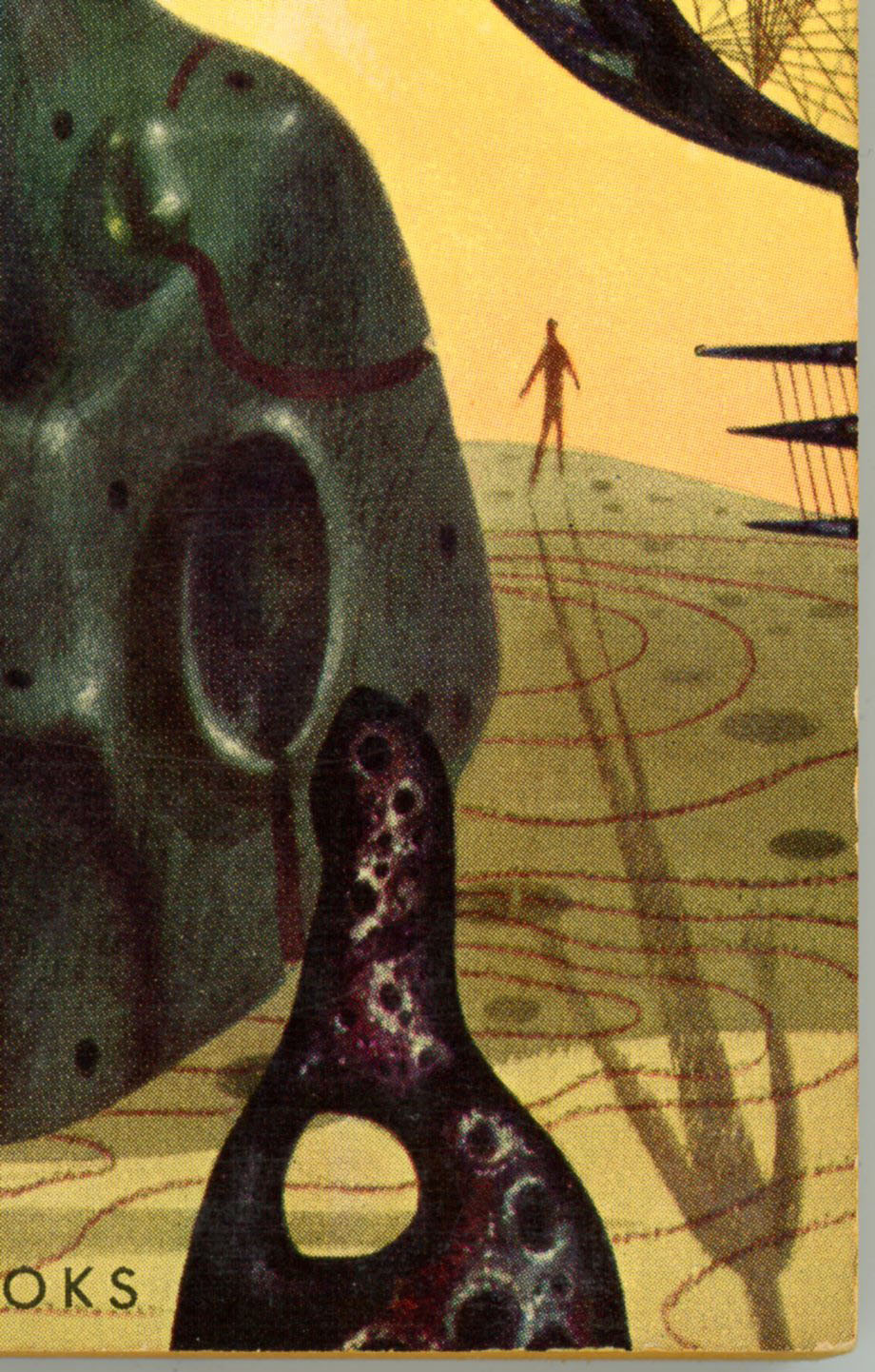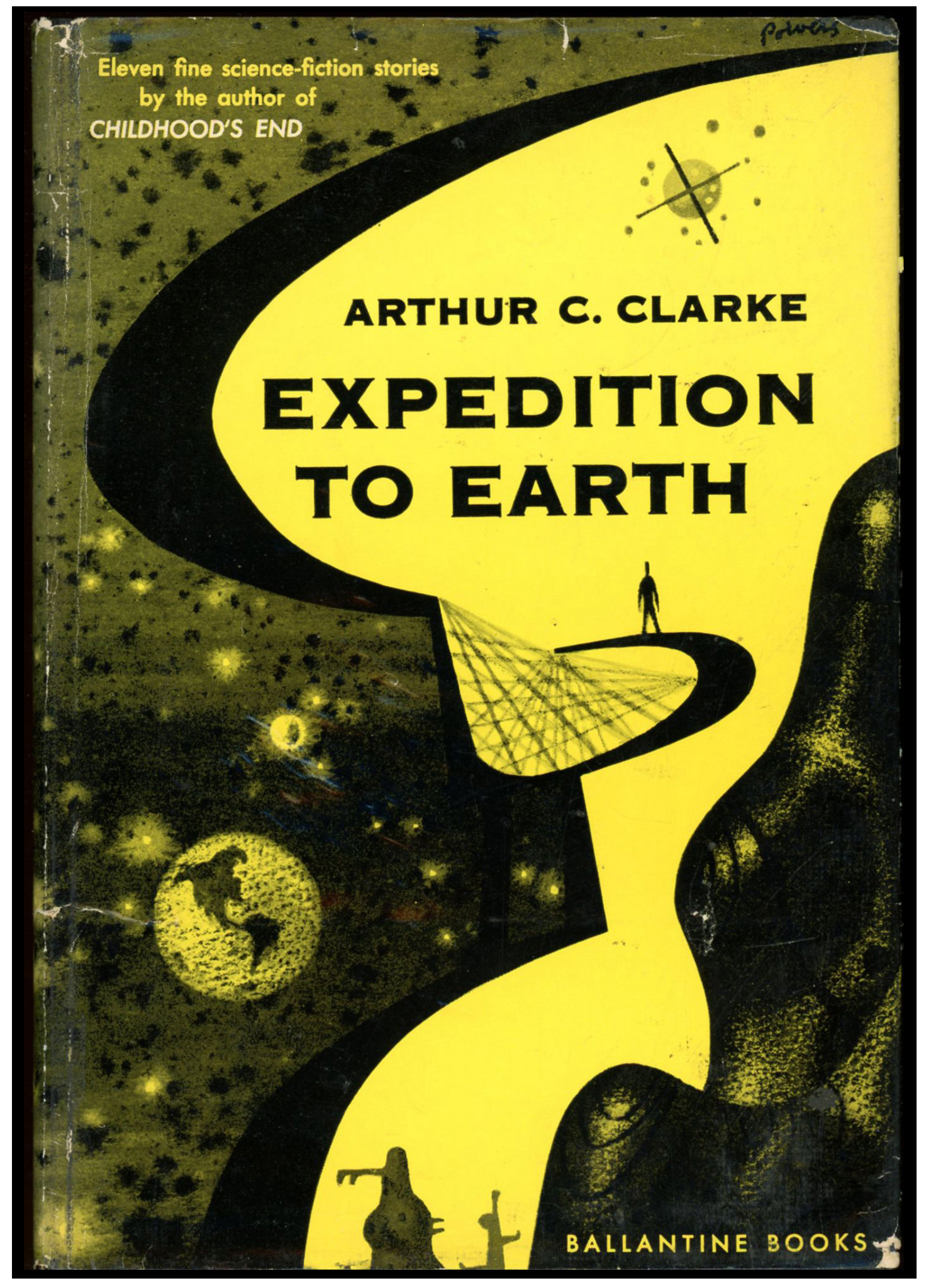Some book covers are outstanding, while others stand out.
A few, do both.
Case in point, Richard Powers’ covers for two anthologies of stories by Arthur C. Clarke – Expedition to Earth, and, Reach for Tomorrow – published by Ballantine Books in 1956 and 1961, respectively. Even in comparison with the visual impact and riveting symbolism characteristic of Powers’ work, these compositions are truly outstanding. They suggest a level of planning, focus, attention to detail, and originality that truly went “one step beyond” (double entendre, there!…) the typically singular nature of his painting. Perhaps – just an idea – the quality of these works was a testimony to Clarke’s by then significance as an author, or, a decision by Ballantine to help generate even greater recognition for Clarke.
So, here’s the cover of Ballantine’s paperback 1961 Expedition to Earth, which is apparently based on and adapted from the cover of the anthology’s 1954 hardback edition. (At bottom of this post!)
Note that while the front cover depicts a massive reddish-brown “thing” (whatever the thing is!…), the rear cover isn’t “vacant”: A latticed sculpture on a curved framework occupies most of the landscape, and could easily be switched to the book’s front cover – the red massif going to the back cover – without losing any impact.
___________________
Here’s a closer view of the massif. Notice the cloudless earth floating in the background? This, and the diminutive figure of a man (we’ll get to him in a moment!), are the only objects that are actually recognizable in the painting, which is bereft even of spacecraft.
___________________
Two things here.
First, the object in the foreground is, I think, actually an anthropomorphic figure; a symbolized man. Though Powers was more than capable of rendering the human figures and faces – whether male or female – in dramatic realism, “people” in many of his paintings from the 50s and 60s were instead represented as elongated, vertically oriented shapes, with legs, torsos, and heads indicated by curves in a figure’s outline. Though I’ve not yet presented examples of his work from the 70s and 80s, a cursory internet search strongly suggests that realistic representations of the human form were by those decades increasingly incorporated into his work.
Second, the tiny, featureless human silhouette in the background – casting a shadow that extends across the cover – figured in a number of Powers’ paintings from this era. Conjecture: Perhaps this was the artist’s way of connoting the insignificance of a man – or mankind – in the face of the unknown, or, in terms of the physical immensity of the universe. Perhaps it’s a way of suggesting awe, wonder, and transcendence. Perhaps – just maybe? – it’s a tiny way of linking the imagined landscape to our reality.
The silhouette reminds me of something else: Brief moments in the latter part of the dream sequence in Alfred Hitchcock’s 1945 Spellbound. I’m certain the resemblance is purely coincidental, and I doubt these few seconds of the movie would have influenced Powers’ work nine years later. But, the similarity is interesting.
You can view the Spellbound dream sequence, care of Passthejointplease, below…
You can be fully spellbound by Spellbound via Old Time Movies, here.
___________________
This close-up of the rear cover shows a smaller version of the massif, set behind the framework supporting the latticed sculpture. The pale green landscape is covered by concentric sets of curves, but, there’s no topography: It’s entirely flat.
Here’s the cover art of the 1961 Ballantine Paperback, sans paperback. Found at Pinterest, this image reveals that the book’s cover art, as published, didn’t fully reflect the range of shades of orange, yellow, and tan in Powers’ original painting. What’s also apparent is that Powers limited the range of colors for land and sky to shades of red, orange, yellow, and olive green, while all other objects are in tones of purple and black.
___________________
Now that we’ve viewed the paperback, let’s take a look at the cover of the hardback first edition.
This image, from John W. Knott Jr. Bookseller, clearly shows that the 1954 hardback cover design was the precursor for that of the 1961 paperback edition. In this version, the earth is very prominently displayed, while the “lattice” occupies the center of the image. Our diminutive silhouette-of-a-man stands nearby, yet virtue of being set against the yellow sky he’s nonetheless prominent. A part of that big red massif stands to the right. And, the sky to the left is speckled with stars. However, unlike the paperback, the first edition’s cover isn’t a wraparound. As you can see at DustJackets.com, the rear cover simply has a few endorsements. Perhaps this “first” cover, as printed by Ballantine in only two shades of color (guess they saved a few bucks that way?), revealed only a small portion of Powers’ original canvas.
When came time for the paperback, his composition could finally be printed – with a few features shifted, enlarged, or deleted – in all its color.
Expedition to Earth was published by Ballantine in 1971 with cover art that – while nice – was conventional. You can view the later edition here.
What’s Inside? (from Internet Speculative Fiction Database)
“Second Dawn”, from Science Fiction Quarterly, August, 1951
“If I Forget Thee, Oh Earth …, from Future, combined with Science Fiction Stories, September, 1951
“Breaking Strain”, from Thrilling Wonder Stories, December, 1949
“History Lesson”, from Startling Stories, May, 1949
“Superiority”, from The Magazine of Fantasy and Science Fiction, August, 1951
“Exile of the Eons”, (variant of “Nemesis”), from Super Science Stories, March, 1950
“Hide and Seek”, from Astounding Science Fiction, September, 1949
“Expedition to Earth”, (variant of “Encounter in the Dawn”), from Amazing Stories, June-July, 1953
“Loophole”, from Astounding Science Fiction, April, 1946
“Inheritance”, from New Worlds #3, October, 1947
“The Sentinel”, from 10 Story Fantasy, Spring, 1951
“About Arthur C. Clarke”, uncredited essay
12/11/22 – 90








